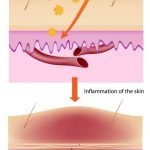Acetaminophen & NSAIDs: Re-evaluating Their Use in the Pediatric Population
Catherine Clinton, ND
Docere
OTC Pain and Fever Reducers Most Widely Used Drugs in Children
Over-the-counter (OTC) pain and fever reducers such as ibuprofen and acetaminophen are the most widely used drugs in children.1 Regular use of these drugs is something I also see in the majority of my pediatric patients. Ibuprofen and acetaminophen are commonly used in infants and children without a full appreciation of their side effects. As naturopathic physicians, it is part of our oath to educate patients. It is often the case that parents are not aware of the full range of side effects of these OTC drugs or alternative options for treating pain and fevers. Everyone deserves to be pain-free, but everyone also deserves education on the full range of options.
This review will be limited to the 2 most common OTC pain relievers – acetaminophen and ibuprofen – including the impact of their mechanisms of action on some of the most common childhood conditions, such as asthma, food allergies, autism spectrum changes, and gut dysbiosis. To truly serve our pediatric patients, the short- and long-term effects of these popular drugs must be fully understood.

Mechanisms of Action
Ibuprofen and acetaminophen have similar mechanisms of action. Both drugs inhibit cyclooxygenases (COXs), the enzymes that catalyze the synthesis of cyclic endoperoxides from arachidonic acid to form prostaglandins and thromboxanes. The COX enzymes, COX-1 and COX-2, are involved with pain and inflammation pathways throughout the body. COX-1 is important for the production of the prostaglandins and thromboxanes responsible for homeostatic balance, eg, temperature regulation via the hypothalamus, platelet aggregation, the regulation of blood flow in the stomach and kidneys, and the regulation of gastric acid secretion. COX enzyme inhibition by non-steroidal anti-inflammatory drugs (NSAIDs) and acetaminophen has several systemic effects that are critical to fully appreciate in our pediatric patients.
The inhibition of the COX enzymes is the driving factor in these drugs’ analgesic effect as well their side effects. Inhibition of COX-1 shunts arachidonic acid metabolism towards the 5-lipoxygenase pathway, which results in an increased synthesis and release of cysteinyl leukotrienes. This pushes the immune system away from Th1-dominance and towards a Th2-dominance and an increase in allergic-type symptoms.
Clinical Associations
Childhood Asthma
There is a clear association between asthma and both ibuprofen and acetaminophen due to the increased leukotriene production and shunting toward Th2 immune dominance.2-4 Use of these 2 drugs can increase inflammation in the respiratory airways of asthmatics or those with a tendency to asthma, resulting in an increase in asthma symptoms. Numerous studies suggest that the association between acetaminophen and asthma is so strong that acetaminophen use in the pediatric population could well explain the dramatic increase in childhood asthma within the last 30 years.5-9
A recent study from 2016, which used data from the Norwegian Mother and Child Cohort Study led by the Norwegian Institute of Public Health, found evidence that acetaminophen use during pregnancy and infancy can increase the risk of developing asthma later in life.10 This study found that prenatal and infant acetaminophen use were independently associated with asthma development.

A 2000 review, published in the European Respiratory Journal, found that areas with more per-capita spending on acetaminophen had a higher incidence of asthma.11 For each gram increase in acetaminophen sales, the prevalence of wheeze increased by 0.52% in 13-14-year-olds and by 0.26% in adults. Interestingly, one study showed that the impact of ibuprofen and acetaminophen on childhood asthma was comparable, suggesting similar associations between asthma and the 2 drugs.12
Gastrointestinal Defects
We have known for some time about the gastrointestinal side effects of ibuprofen use. Inhibition of the COX-1 enzyme decreases blood flow to the gastrointestinal mucosa, resulting in impaired mucosal defenses that can lead to mucosal injury.13 Inhibition of protective prostaglandins in the GI tract also causes diminished bicarbonate and mucus secretion. This makes the GI mucosa vulnerable to an increase in acidic molecules that can easily irritate the unprotected mucosa, leave it less able to heal from the damage.14
Recent studies demonstrate that the ibuprofen-induced increase in acidic molecules and decreases in protective prostaglandins, gastric secretions, and mucus together initiate microbiome changes that lead to increased intestinal permeability (aka leaky gut) within 24 hours of NSAID ingestion.15-17 Another recent study looked the microbiomes of 155 individuals and how NSAIDs impacted the composition of the gut microbiota.18 Findings indicated that the number of drugs didn’t impact the microbiome as much as the type of drugs ingested. Specifically, different NSAIDs were associated with different bacterial patterns, suggesting that NSAIDs have direct effects on the microbiome. This gastrointestinal damage seen with NSAID use is common in children and deserves more widespread awareness.19-20
This NSAID-induced gut permeability has profound implications for the high prevalence of pediatric food allergies. In a recent mouse study, NSAIDs were shown to cause a transient leaky gut due to defects in GI lining integrity, which was associated with an increase in gluten sensitivity.21 Even more convincing is a recent study demonstrating that NSAIDs were a required trigger in 40% of food allergy anaphylaxis caused by lipid transfer protein (LTP), a common trigger of food allergy reactions.22 This study showed NSAID use to produce a marked increase in zonulin, a modulator of permeability in intercellular tight junctions that line the GI tract. The amplifying effect of NSAIDs on food allergy is well documented, including reactions to shellfish, gliadin, peanuts, and sunflower seeds, in addition to LTP.23-26 This is a huge consideration when treating the multitude of pediatric patients we see with food allergies and sensitivities.
Glutathione & Mitochondria
Acetaminophen has another serious side effect that impacts the health of our pediatric patients. Recent research found that acetaminophen depletes cellular glutathione at a rapid rate in respiratory cells.27 This study suggested that the link between acetaminophen and asthma was not just from the increase in inflammation and Th2 shunting of the immune system but also from the depletion of glutathione in the mucosa of the airways. The rapid exhaustion of glutathione stores is also the cause of liver damage associated with acetaminophen use.28
Not surprisingly, research has also shown an association between mitochondrial damage and acetaminophen use.29, 30 Mitochondria are a common target of drug toxicity. Injury can occur either directly or indirectly through reactive metabolites that promote mitochondrial oxidative stress and changes in the permeability of the mitochondrial transport membrane, ultimately leading to cell death. This mimics the mitochondrial damage we also see with NSAID use.31
Behavioral Disorders
Acetaminophen exposure in pregnancy or in early life has also been associated with neurological changes, probably due to multiple mechanisms of action, such as glutathione depletion, immune dysregulation, oxidative stress, and mitochondrial damage.
Multiple studies have revealed an association between acetaminophen use in pregnancy and hyperkinetic disorders and ADHD.32-34 These studies were especially interesting because the results did not appear to be confounded by maternal inflammation, infection during pregnancy, the mother’s mental health problems, or other potential confounders.

Another recent study, examining siblings and the effect of acetaminophen on their neurodevelopment, found that siblings that were exposed to acetaminophen prenatally had poorer gross motor development, communication, externalizing behavior, internalizing behavior, and higher activity levels compared to their unexposed siblings.35 While we shouldn’t be quick to pin multifactorial conditions like hyperkinetic disorders or ADD/ADHD on a single cause, these studies should at least give us pause when evaluating and treating our pediatric patients.
Summary
This review should not be seen as a blanket condemnation of acetaminophen and ibuprofen. There is a time and place for OTC pain relievers, and although it is rare, I have recommended them to patients. For example, OTC pain medications can be useful at times when sleep is adversely affected by the pain of an infection, since sleep is necessary for robust immune responses. Sometimes the pain and inflammation of acute injuries also warrant NSAID use to effectively treat the patient; however, these occasions are rare and the alternatives are plenty.
Naturopathic medicine aims to find the root cause of a patient’s pain, has a variety of tools with which to treat pain and fevers, and is well positioned to appreciate the role of OTC drugs in the health of our pediatric patients. Appreciating the wide-ranging impacts that acetaminophen and ibuprofen have on our pediatric population’s clinical picture is vital and should be imperative in any medical practice that treats infants and children.
References:
- Aghababian RV. Essentials of Emergency Medicine. Burlington, MA: Jones & Bartlett Learning; 2010.
- McBride JT. The association of acetaminophen and asthma prevalence and severity. Pediatrics. 2011;128(6):1181-1185.
- Debley JS, Carter ER, Gibson RL, et al. The prevalence of ibuprofen-sensitive asthma in children: a randomized controlled bronchoprovocation challenge study. J Pediatr. 2005;147(20):233-238.
- Lo PC, Tsai YT, Lin SK, Lai JN. Risk of asthma exacerbation associated with nonsteroidal anti-inflammatory drugs in childhood asthma: A nationwide population-based cohort study in Taiwan. Medicine (Baltimore). 2016;95(41):e5109.
- Barr RG. Does paracetamol cause asthma in children? Time to remove the guesswork. Lancet. 2008;372(9643):1011-1012.
- Etminan M, Sadatsafavi M, Jafari S, et al. Acetaminophen use and the risk of asthma in children and adults: a systematic review and metaanalysis. Chest. 2009;136(5):1316-1323.
- Holgate ST. The acetaminophen enigma in asthma. Am J Respir Crit Care Med. 2011;183(2):147-148.
- Farquhar H, Stewart A, Mitchell E, et al. The role of paracetamol in the pathogenesis of asthma. Clin Exp Allergy. 2010;40(1):32-41.
- Johnson CC, Ownby DR. Have the efforts to prevent aspirin-related Reye’s syndrome fuelled an increase in asthma? Clin Exp Allergy. 2011;41(3):296-298.
- Magnus MC, Karlstad Ø, Håberg SE, et al. Prenatal and infant paracetamol exposure and development of asthma: the Norwegian Mother and Child Cohort Study. Int J Epidemiol. 2016;45(2):512-522.
- Newson RB, Shaheen SO, Chinn S, Burney PG. Paracetamol sales and atopic disease in children and adults: an ecological analysis. Eur Respir J. 2000;16(5):817-823.
- Sheehan WJ, Mauger DT, Paul IM, Moy JN. Acetaminophen versus Ibuprofen in Young Children with Mild Persistent Asthma. N Engl J Med. 2016;375(7):619-630.
- Sostres C, Gargallo CJ, Lanas A. Nonsteroidal anti-inflammatory drugs and upper and lower gastrointestinal mucosal damage. Arthritis Res Ther. 2013;15 Suppl 3:S3.
- Wallace JL. Prostaglandins, NSAIDs, and gastric mucosal protection: why doesn’t the stomach digest itself? Physiol Rev. 2008;88(4):1547-1565.
- Montalto M, Gallo A, Curigliano V, et al. Clinical trial: the effects of a probiotic mixture on non-steroidal anti-inflammatory drug enteropathy – a randomized, double-blind, cross-over, placebo-controlled study. Aliment Pharmacol Ther. 2010;32(2):209-214.
- Bjarnason I, Takeuchi K. Intestinal permeability in the pathogenesis of NSAID-induced enteropathy. J Gastroenterol. 2009;44 Suppl 19:23-29.
- Otani K, Tanigawa T, Watanabe T, et al. Microbiota Plays a Key Role in Non-Steroidal Anti-Inflammatory Drug-Induced Small Intestinal Damage. Digestion. 2017;95(1):22-28.
- Rogers MA, Aronoff DM. The influence of non-steroidal anti-inflammatory drugs on the gut microbiome. Clinical Microbiology Infect. 2016;22(2):178.e1-178.e9.
- Cardile S, Martinelli M, Barabino A, et al. Italian survey on non-steroidal anti-inflammatory drugs and gastrointestinal bleeding in children. World J Gastroenterol. 2016;22(5):1877-1883.
- Boukthir S, Mazigh SM, Kalach N, et al. The effect of non-steroidal anti-inflammatory drugs and Helicobacter pylori infection on the gastric mucosa in children with upper gastrointestinal bleeding. Pediatr Surg Int. 2010;26(2):227-230.
- Natividad JM, Huang X, Slack E, et al. Host responses to intestinal microbial antigens in gluten-sensitive mice. PLoS One. 2009;4(7):e6472.
- Muñoz-Cano R, Pascal M, Bartra J, et al. Distinct transcriptome profiles differentiate NSAID-dependent from NSAID-independent food anaphylaxis. J Allergy Clin Immunol. 2016;137(1):137-146.
- Vidal C, Bartolomé B, Gonzalez-Quintela A, et al. Prawns, barnacles, and nonsteroidal anti-inflammatory drugs: effect modifiers or diagnostic confounders. J Investig Allergol Clin Immunol. 2007;17(2):113-118.
- Matsukura S, Aihara M, Sugawara M, et al. Two cases of wheat-dependent anaphylaxis induced by aspirin administration but not by exercise. Clin Exp Dermatol. 2010;35(3):23-27.
- Matsuo H, Morimoto K, Akaki T, et al. Exercise and aspirin increase levels of circulating gliadin peptides in patients with wheat-dependent exercise-induced anaphylaxis. Clin Exp Allergy. 2005;35(4):461-466.
- Bol-Schoenmakers M, Bleumink R, Marcondes Rezende M, et al. Diclofenac enhances allergic responses in a peanut allergy model. Clin Exp Allergy. 2011;41(3):424-433.
- Dimova S, Hoet PH, Dinsdale D, Nemery B. Acetaminophen decreases intracellular glutathione levels and modulates cytokine production in human alveolar macrophages and type II pneumocytes in vitro. Int J Biochem Cell Biol. 2005;37(8):1727-1737.
- Vickers AE, Ulyanov AV, Fisher RL. Liver Effects of Clinical Drugs Differentiated in Human Liver Slices. Int J Mol Sci. 2017;18(3). pii: E574.
- Jaeschke H, McGill MR, Ramachandran A. Oxidant stress, mitochondria, and cell death mechanisms in drug-induced liver injury: lessons learned from acetaminophen hepatotoxicity. Drug Metab Rev. 2012;44(1):88-106.
- Jiang J, Briedé JJ, Jennen DG. Increased mitochondrial ROS formation by acetaminophen in human hepatic cells is associated with gene expression changes suggesting disruption of the mitochondrial electron transport chain. Toxicol Lett. 2015;234(2):139-150.
- Roediger WE, Millard S. Selective inhibition of fatty acid oxidation in colonocytes by ibuprofen: a cause of colitis? Gut. 1995;36(1):55-59.
- Liew Z, Ritz B, Rebordosa C, et al. Acetaminophen use during pregnancy, behavioral problems, and hyperkinetic disorders. JAMA Pediatr. 2014;168(4):313-320.
- Liew Z, Ritz B, Virk J, Olsen J. Maternal use of acetaminophen during pregnancy and risk of autism spectrum disorders in childhood: A Danish national birth cohort study. Autism Res. 2016;9(9):951-958.
- Thompson JM, Waldie KE, Wall CR. Associations between acetaminophen use during pregnancy and ADHD symptoms measured at ages 7 and 11 years. PLoS One. 2014;9(9):e108210.
- Brandlistuen RE, Ystrom E, Nulman I, et al. Prenatal paracetamol exposure and child neurodevelopment: a sibling-controlled cohort study. Int J Epidemiol. 2013;42(6):1702-1713.
Image Copyright: <a href=’https://www.123rf.com/profile_dimasobko’>dimasobko / 123RF Stock Photo</a>
 Catherine Clinton ND, is a board-licensed naturopathic doctor and graduate of NCNM in Portland, OR. She currently practices at her private clinic in Eugene, OR. Catherine lectures on integrative medicine and gut health and has authored several publications in these areas. During medical school, Catherine was diagnosed with a GI autoimmune disease, which stimulated an special interest in gastrointestinal and immune health. Her own journey to health has helped to inspire her patients as well as her writing. With the birth of her own children, Catherine’s passion extended to the GI and immune health of all children. Catherine’s blog can be found at www.wellfuture.com/blog, or you can follow her at Facebook (https://www.facebook.com/dr.catherineclintonnd/) and Twitter (@DrCatherineND).
Catherine Clinton ND, is a board-licensed naturopathic doctor and graduate of NCNM in Portland, OR. She currently practices at her private clinic in Eugene, OR. Catherine lectures on integrative medicine and gut health and has authored several publications in these areas. During medical school, Catherine was diagnosed with a GI autoimmune disease, which stimulated an special interest in gastrointestinal and immune health. Her own journey to health has helped to inspire her patients as well as her writing. With the birth of her own children, Catherine’s passion extended to the GI and immune health of all children. Catherine’s blog can be found at www.wellfuture.com/blog, or you can follow her at Facebook (https://www.facebook.com/dr.catherineclintonnd/) and Twitter (@DrCatherineND).









